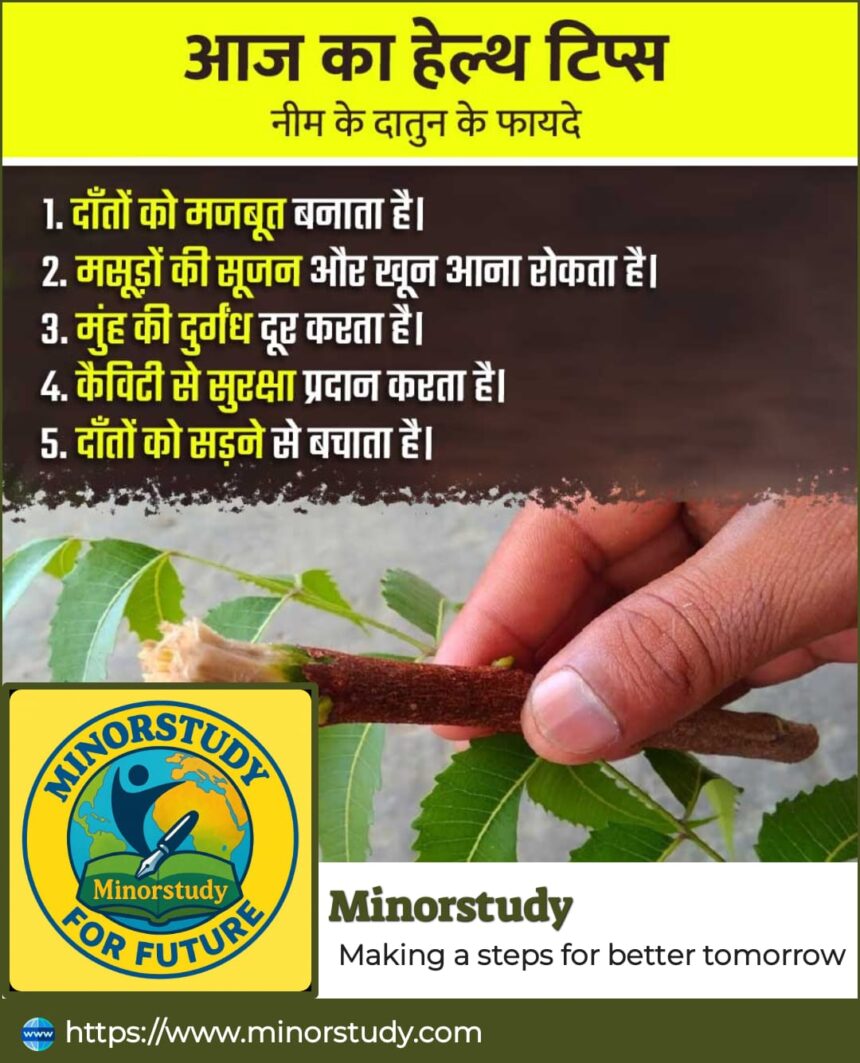Introduction – The Ancient Toothbrush That Still Wins Hearts
In today’s world of electric toothbrushes and expensive toothpaste, there’s an age-old, zero-cost, eco-friendly dental care secret that has stood the test of time – Neem Datun.
A Datun is essentially a fresh twig of the neem tree (Azadirachta indica), chewed to form bristles and used as a toothbrush. This simple green stick, long valued in Ayurveda, is a powerhouse of antibacterial, antifungal, and anti-inflammatory properties. For centuries, millions of people in India and other parts of Asia have started their mornings with this humble herbal gift.
- History of Neem Datun
- Timeline – Neem Datun Through the Ages
- Top 7 Benefits of Neem Datun
- Interesting Facts About Neem Datun
- Significance in Ayurveda and Culture
- How to Use Neem Datun Correctly
- Observance – Modern & Traditional
- Wishing & Wellness Message
- Importance in Daily Life
- FAQs – Neem Datun
- Conclusion – A Bite of the Past for a Bright Future
Let’s explore the history, benefits, cultural relevance, and modern-day significance of Neem Datun.
History of Neem Datun
Neem, known as the “Village Pharmacy” in rural India, has been used for more than 4,500 years in traditional Indian medicine. Historical references can be traced back to:
Ayurveda (Sushruta Samhita & Charaka Samhita) – which describe neem twigs for dental hygiene.
Indus Valley Civilization excavations – where researchers found evidence of neem twig usage.
Ancient travel accounts – Chinese Buddhist monks traveling to India noted the unique practice of chewing medicinal sticks.
In ancient Indian villages, neem trees were planted near homes and temples not just for shade, but for easy access to fresh Datun every morning.
Timeline – Neem Datun Through the Ages
~2500 BCE: Early evidence from Harappa and Mohenjo-Daro of twig-based oral cleaning.
~1500 BCE: Ayurveda texts praise neem’s role in strengthening gums and teeth.
10th Century CE: Neem Datun becomes common in rural households across India.
18th–19th Century: British colonial officers note the habit and sometimes adopt it.
20th Century: Toothbrushes and toothpaste begin replacing traditional Datun in urban India.
21st Century: Ayurveda revival brings Neem Datun back into health trends worldwide.
Top 7 Benefits of Neem Datun
Here’s why the Neem Datun deserves a spot in your daily routine:
Makes Teeth Stronger
Neem’s mineral content strengthens enamel, making teeth more resistant to wear and tear.Prevents Swelling and Bleeding of Gums
Its anti-inflammatory properties reduce gum irritation and swelling.Eliminates Bad Breath
Natural antibacterial agents kill odor-causing bacteria.Provides Protection from Cavities
Neem extracts fight Streptococcus mutans – the main bacteria behind cavities.Prevents Tooth Decay
Regular use slows plaque formation and maintains oral pH balance.Boosts Immunity in the Mouth
Phytochemicals create a protective barrier against infections.Eco-Friendly and Cost-Free
No plastic waste, no chemical foaming agents – just a twig from nature.
Interesting Facts About Neem Datun
Neem is called “Arista” in Sanskrit, meaning “perfect, complete, and imperishable.”
Villagers often chew the bitter neem twig for 5–10 minutes before brushing.
The World Health Organization (WHO) has acknowledged chewing sticks as effective for oral hygiene.
Neem Datun works like a toothbrush + toothpaste + mouthwash in one.
Significance in Ayurveda and Culture
In Ayurveda, dental care is part of Dinacharya (daily routine). Neem is categorized as:
Tikta Rasa (bitter taste) – removes toxins from the mouth.
Kashaya Rasa (astringent) – tightens gums and reduces bleeding.
Shita Virya (cool potency) – soothes oral inflammation.
Culturally, Neem Datun is not just hygiene – it’s symbolic of purity. In many villages, starting the day with a Datun is as important as offering prayers.
How to Use Neem Datun Correctly
Choose a fresh, thin neem twig (8–10 inches long).
Remove the bark from one end.
Chew the end gently until bristles form.
Brush teeth in gentle circular motions.
Use the bitter juice to rinse your mouth.
Discard after one use – always use fresh.
Observance – Modern & Traditional
Traditionally:
People collected fresh neem twigs every morning.
Used outside the home, under the neem tree, often while chatting with neighbors.
Modern Approach:Ayurvedic stores now sell ready-to-use neem sticks.
Some toothpaste brands incorporate neem extracts for urban consumers.
Wishing & Wellness Message
“May your mornings be fresh, your smile strong, and your health evergreen – just like the Neem tree. A small twig today can plant the roots of lifelong wellness.”
Importance in Daily Life
For Individuals: Improves dental health naturally.
For Environment: Reduces plastic waste from toothbrushes.
For Society: Revives a sustainable, traditional health practice.
FAQs – Neem Datun
Q1: Can Neem Datun replace toothpaste?
A: Yes, if used properly, it can replace both toothbrush and toothpaste.
Q2: Is Neem Datun safe for children?
A: Yes, but ensure they chew gently to avoid gum injury.
Q3: How often should I use Neem Datun?
A: Daily, preferably in the morning.
Q4: Does it whiten teeth?
A: Regular use helps remove stains and improves natural whiteness.
Q5: Is it better than a toothbrush?
A: In many rural areas, it has been more effective due to its medicinal properties.
Conclusion – A Bite of the Past for a Bright Future
Neem Datun is not just a dental tool – it’s a bridge between ancient wisdom and modern wellness. In an age of chemical-laden oral care products, this bitter twig offers a refreshing, eco-friendly, and medicinal alternative.
By embracing Neem Datun, we aren’t just cleaning our teeth; we’re connecting with nature, preserving culture, and protecting the planet.
So tomorrow morning, before you reach for that toothpaste tube, remember – sometimes the simplest solutions are the most powerful.








